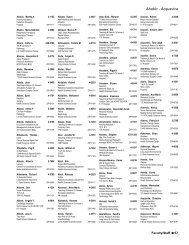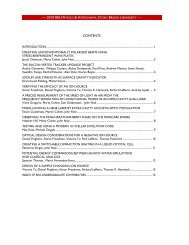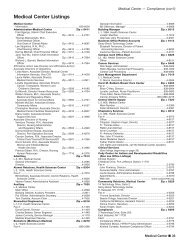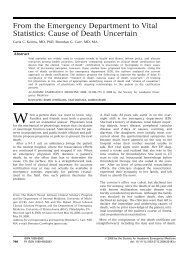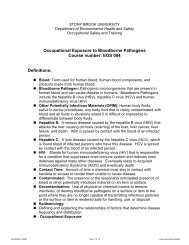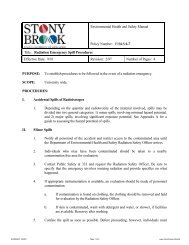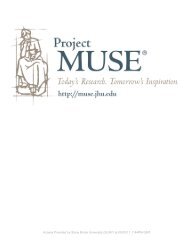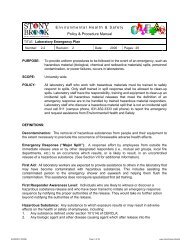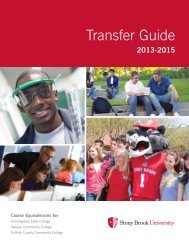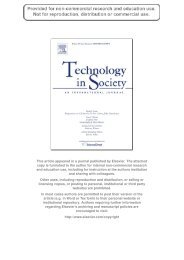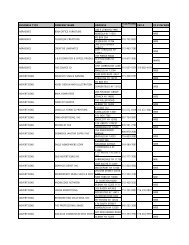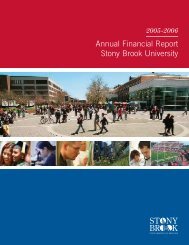NUCLEAR PHYSICS - Stony Brook University
NUCLEAR PHYSICS - Stony Brook University
NUCLEAR PHYSICS - Stony Brook University
You also want an ePaper? Increase the reach of your titles
YUMPU automatically turns print PDFs into web optimized ePapers that Google loves.
Experimental Nuclear Physics at <strong>Stony</strong> <strong>Brook</strong><br />
Past, Present, and Future<br />
Prof. Gene D. Sprouse<br />
<strong>Stony</strong> <strong>Brook</strong>
• Nov 24, 2006 4:00 pm Superconducting<br />
LINAC completed its last experiment at<br />
<strong>Stony</strong> <strong>Brook</strong><br />
• This is an opportune time to review the<br />
history of the Van de Graaff and the<br />
LINAC and the people involved in their<br />
acquisition and operation, and to look into<br />
the future a little.
1975<br />
1966<br />
Van de Graaff<br />
1968<br />
Superconducting<br />
LINAC 1983
Department of Physics 1964<br />
Bob<br />
deZafra<br />
Cliff<br />
Swartz<br />
Juliet<br />
Lee-<br />
Franzini<br />
Arnie<br />
Feingold<br />
Peter<br />
Kahn<br />
Alec<br />
Pond
Proposal for EN tandem Van<br />
de Graaff to SUNY-Alec Pond
Van de Graaff proposal<br />
s<br />
person
Time Line for proposal<br />
• 14 Dec 1962 Proposal prepared for EN (6MV) VdG.<br />
• 24 Jan 1963 NSF issues positive report on Nuc. Physics,<br />
proposing to double funding and make money<br />
available to build facilities<br />
• 13 Feb 1963 Provost Porter gets positive review
Time Line for proposal<br />
• 14 Dec 1962 Proposal prepared for EN (6MV) VdG.<br />
• 24 Jan 1963 NSF issues positive report on Nuc. Physics,<br />
proposing to double funding and make money<br />
available to build facilities<br />
• 13 Feb 1963 Provost Porter gets positive review<br />
• 15 April 1964 State Legislature appropriates $1.35M for<br />
machine and ½ of the building,
Time Line for proposal<br />
• 14 Dec 1962 Proposal prepared for EN (6MV) VdG.<br />
• 24 Jan 1963 NSF issues positive report on Nuc. Physics,<br />
proposing to double funding and make money<br />
available to build facilities<br />
• 13 Feb 1963 Provost Porter gets positive review<br />
• 15 April 1964 State Legislature appropriates $1.35M for<br />
machine and ½ of the building,<br />
• 27 October 1964 NSF grant for ½ of building ($291k) approved.
Pond<br />
Proposes<br />
going for an<br />
FN(King)<br />
rather than an<br />
EN(Standard).<br />
This is known<br />
as “bait and<br />
switch”
Time Line for proposal<br />
• 14 Dec 1962 Proposal prepared for EN (6MV) VdG.<br />
• 24 Jan 1963 NSF issues positive report on Nuc.<br />
Physics, proposing to double funding and make money<br />
available to build facilities<br />
• 13 Feb 1963 Provost Porter gets positive review<br />
• 15 April 1964 State Legislature appropriates $1.35M<br />
for machine and ½ of the building,<br />
other ½ ($291k) from NSF funding.<br />
• Jan 1 1965 First NSF research grant for $34,000<br />
• Sept 1965 Lin Lee, Dave Fossan hired<br />
• Sept 1966 Peter Paul, Bob Weinberg hired<br />
• Oct 1966 Building started
October-10-1966 (view from top of Harriman Hall toward<br />
Old Chemistry. Trees are site of Grad Chemistry building)
November-10-1966
December-5-1966
February-1-1967
February-1-1967
Completed Van de Graaff building<br />
Trees at right rear of the building will become site of Grad Physics Building
Delivery of the Van de Graaff tank<br />
We all live in a yellow submarine,<br />
Yellow submarine, yellow submarine,<br />
We all live in a yellow submarine,<br />
Yellow submarine, yellow submarine,
Tank entering the building
Current picture of the Van de Graaff
Van deGraaff<br />
Nuclear Experiment Facilities and Faculty 1965-2007<br />
FACULTY<br />
Robert Weinberg<br />
Linwood Lee<br />
David Fossan<br />
Peter Paul<br />
Robert McGrath<br />
Gene Sprouse<br />
65 66 67 68 69 70 71 72 73 74 75<br />
resigned
Van de Graaff Physics Programs<br />
Gamma Ray Spectroscopy Dave Fossan<br />
Giant Dipole Resonance Peter Paul<br />
Charged Particle Reactions Bob McGrath<br />
Lin Lee<br />
Nuclear moments and applications<br />
to Solid State, Atomic Physics Gene Sprouse
Two PDP-9 computers from DEC, each costing $100,000. The “big”<br />
machine had 16k 18 bit memory cells, and the “small” one 8k!
The machine ran 24-7, and we hired people<br />
to operate the machine at night.
Dr. Dan Dietrich, Livermore.<br />
(Metcalf student who did thesis<br />
with van de Graaff)<br />
Dr. Ron Chestnut,<br />
CPE at SLAC<br />
Dr. Phil Goldstone,<br />
Los Alamos
The lab ski trip
Igloo 101
Fred Raab, head of the<br />
LIGO Hanford Observatory<br />
(Metcalf student)<br />
Ehud Dafni, VP Business<br />
Development, CMT<br />
Prof. Steve Rolston,<br />
Assoc. Chairman, Univ of<br />
Md.<br />
Prof. Partha Chowdhury,<br />
Univ of Mass. Lowell
Prof. Gunter Schatz,<br />
Univ. Konstanz<br />
Dr. John Noe,<br />
Laser Teaching Center
• Friedlander Panel on Future of Nuclear Science<br />
NAS/NRC, 1975–77 recommends that two<br />
<strong>University</strong> Van de Graaffs should get “booster<br />
accelerators”<br />
• Peter Paul motivates the group to compete for<br />
one of these two.<br />
• Collaboration initiated with Cal Tech to build a<br />
superconducting LINAC at <strong>Stony</strong> <strong>Brook</strong>(We<br />
could not buy LINAC like vdG)<br />
• Paul and Sprouse stop physics research to<br />
devote full time to the project
To expedite the transfer of the superconducting resonator<br />
technology to <strong>Stony</strong> <strong>Brook</strong>, Sprouse spends a semester at<br />
Cal Tech. Whose car is this??
Collaboration with Cal Tech to build<br />
superconducting resonators
• There were competing development<br />
proposals to NSF from:<br />
– Stanford(Hanna, Glavish and Ben Zvi)<br />
– <strong>Stony</strong> <strong>Brook</strong>(Paul and Sprouse)<br />
• <strong>Stony</strong> <strong>Brook</strong> won!
Testing the Prototype superconducting<br />
resonator with beam<br />
Ilan BenZvi,<br />
Director of the<br />
Accelerator<br />
Test Facility,<br />
BNL
Next step: Test a prototype module<br />
containing 3 resonators
What is the difference between these two proposals?
The advanced computer control system of the<br />
accelerator was developed primarily by a PhD. Student<br />
Dr. Alfred Scholldorf,<br />
VP for development at Reuters
Joseph M. Brennan,<br />
AGS Department, BNL
Mike Brennan and<br />
Chen Chia-erh,<br />
work on the beam sweeper<br />
Chen later becomes<br />
President of Beijing<br />
<strong>University</strong> and President of<br />
the Chinese Physical<br />
Society
Linac room before
400 W Helium Refrigerator Installation<br />
Professor Miriam<br />
Rafailovich, Director,<br />
Garcia Center,<br />
Materials Science<br />
Department, <strong>Stony</strong><br />
<strong>Brook</strong>
Helium gas storage tank delivery
Installation of Bob McGrath’s<br />
scattering chamber “big mac”
Linac room before
Linac room after
• SCIENCE Volume 291, Number 5506, 9 Feb<br />
2001, p. 962.<br />
Copyright © 2001 by The American Association<br />
for the Advancement of Science.<br />
• <strong>NUCLEAR</strong> <strong>PHYSICS</strong>:<br />
Nuclei Crash Through The Looking-Glass<br />
• David Voss<br />
• Gloves do it. Toupees do it. Even twists of DNA<br />
do it. And now, for the first time, physicists have<br />
discovered that atomic nuclei come in right- and<br />
left-handed models, too. In the 5 February issue<br />
of Physical Review Letters (PRL), a team of<br />
researchers from the State <strong>University</strong> of New<br />
York (SUNY), Yale, the <strong>University</strong> of<br />
Tennessee, and Notre Dame reports<br />
observations of rapidly spinning nuclei morphing<br />
into mirror-image forms. In the process, the<br />
physicists also uncovered solid evidence that a<br />
long-disputed feature of nuclear anatomy really<br />
does exist.<br />
Starosta, Fossan, Koike,<br />
LaFosse, Beausang, and<br />
Vaman
Lifetime(seconds)<br />
Nuclear Lifetimes of Fr Isotopes<br />
(work done with Luis Orozco, now at UMd.)<br />
1.E+04<br />
1.E+02<br />
1.E+00<br />
1.E-02<br />
1.E-04<br />
1.E-06<br />
1.E-08<br />
201<br />
Made at <strong>Stony</strong> <strong>Brook</strong> Boulder<br />
205<br />
209<br />
213<br />
217<br />
Isotope<br />
221<br />
225<br />
229
Francium Atomic Level Scheme<br />
(work done with Luis Orozco, now at UMd.)<br />
9s<br />
107.53±0.90 ns. 83.5±1.5 ns<br />
8s<br />
7s<br />
53.48 +- 0.33 ns<br />
149.3±3.5 ns<br />
8p3/2 8p1/2 7p 3/2<br />
21.02+-0.11 ns<br />
7p 1/2<br />
29.45+-0.11 ns<br />
trapping transition<br />
718 nm<br />
67.7+-2.9 ns<br />
7d5/2 7d3/2 73.60+-0.3 ns<br />
6d 5/2<br />
6d 3/2<br />
Found at <strong>Stony</strong><br />
<strong>Brook</strong><br />
Still unknown
Dave Fossan Bob McGrath Gene Sprouse<br />
Lin Lee Peter Paul
Aniko Paul Dot Lee Carolyn McGrath<br />
Ann Fossan H’y Sprouse
DAVID B. FOSSAN (1934-2003)<br />
21 Ph.D. students, 17 postdoctorates,<br />
260 refereed publications<br />
First recipient of “Chancellor’s Award for<br />
Excellence in Research and Creative Activity”<br />
1. Neutron Total Cross Sections of Be, 10B, B, C and O, D.B. Fossan and<br />
R.L. Walter, W.E. Wilson and H.H. Barschall, Phys. Rev. 123, 209 (1961).<br />
• 2. Differential Cross Sections for the T(p,n)3He Reaction, W.E. Wilson,<br />
• R.L. Walter and D.B. Fossan, Nucl. Phys. 27, 421 (1961).<br />
• 3. Rotational-State Lifetimes, D.B. Fossan and B. Herskind, Phys. Letters 2, 155 (1962).<br />
• 4. Half-Lives of Two Excited States in 172Yb, B. Herskind and D.B. Fossan, Nucl. Phys. 40, 489<br />
(1963).<br />
• 5. Half-Lives of First Excited 2+ States (150
Dave Fossan, one of the creators<br />
of “Gammasphere”
Funding/year<br />
$2,000,000<br />
$1,000,000<br />
$0<br />
1965<br />
NSF Funding of Nuclear Structure Laboratory<br />
1968<br />
1971<br />
1974<br />
1977<br />
1980<br />
1983<br />
∫ = $41.2Μ<br />
1986<br />
Year<br />
1989<br />
1992<br />
1995<br />
1998<br />
2001<br />
2004<br />
2007
Department Visiting Committee<br />
Comments on Nuclear Physics
The Future:<br />
Linac:<br />
Beijing Atomic Energy Institute wishes to<br />
acquire the LINAC as a booster for their tandem.<br />
Van de Graaff:<br />
MARIACHI (Cosmic ray detectors for<br />
outreach to high schools)<br />
Tandem Teaching Lab (experiments for<br />
advanced laboratory, and C 14 dating for<br />
outreach)<br />
Detector Research and Development<br />
A. Deshpande, A. Drees, T.K.<br />
Hemmick, B. Jacak, M. Marx
Mariachi Workshops
Accelerator Mass Spectrometry<br />
• AMS is well established for 14 C, 10 Be, 26 Al, 36 Cl,<br />
41 Ca, 129 I.<br />
• 14 C is the familiar “dating” isotope for biological<br />
samples.<br />
• Living materials contain 14 C/ 12 C~10 -12<br />
• After death, ratio decays t 1/2 =5730 yr<br />
• Accelerator used to strip ions to +3 charge state,<br />
eliminating molecules.<br />
• 12 C via beam current, 14 C via count rate
Proposed Lab Layout:<br />
MARIACHI<br />
14 C<br />
Grad Lab<br />
Det R&D<br />
Winder
Concluding remarks<br />
• Alec Pond’s vision has largely been realized:<br />
The purchase of the Van de Graaff was one of<br />
several statements that <strong>Stony</strong> <strong>Brook</strong> intended to<br />
be a major research university.<br />
• Peter Paul’s vision to go after the LINAC has<br />
paid off well.<br />
• Peter also played a pivotal role in securing RHIC<br />
for BNL.<br />
• The Van de Graaff will continue as a productive<br />
educational and outreach tool.
Personal remarks<br />
• Came to <strong>Stony</strong> <strong>Brook</strong>, January 1970<br />
• Will go on 5 year leave, starting January 2007 to<br />
become Editor in Chief of the American Physical<br />
Society.<br />
• I have worked hard for <strong>Stony</strong> <strong>Brook</strong>, and <strong>Stony</strong><br />
<strong>Brook</strong> has been good to me. I’ve enjoyed my<br />
interactions with my colleagues and the<br />
outstanding SB students, especially the last 4<br />
years teaching Honors Physics 141-2.<br />
• My new job is different, with new challenges,<br />
and I’m excited about taking them on.
The End<br />
For material used in this presentation, many thanks to:<br />
Peter Kahn, Lin Lee, and John Noe



